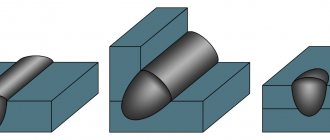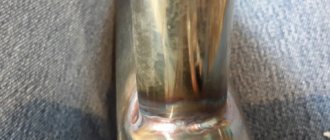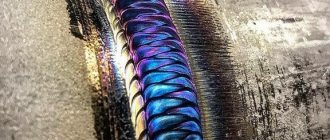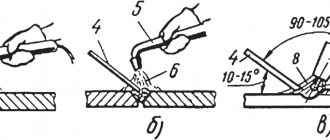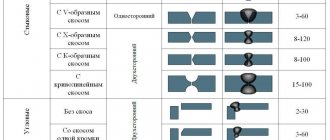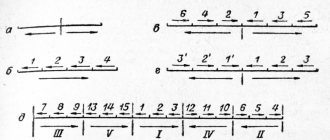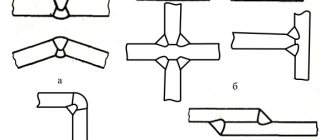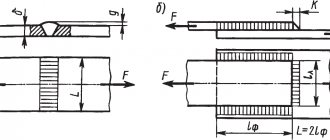During the production process, the need to weld thin sheets to thick ones occurs quite often. But the use of contact electrodes of the usual diameter of 4 mm for thick metal is completely unsuitable for welding thin metal. This problem can be solved if we carry out preliminary preparation operations. We will tell you which ones exactly in our article.
Electroslag welding
Electroslag welding (ESW) allows you to weld metal parts up to 60 cm thick. The principle of ESW is that a slag mass is placed in the gap between the ends of two metal parts being welded. This mass is melted by an electric arc created between the electrode and the metal parts. After the slag has melted, the arc goes out, and a current flows through the slag mass, which, with correctly selected welding parameters, evenly heats the weld pool to high temperatures.
A filler material is added to the slag mass, which melts along with the slag and the edges of the parts being joined. Since the molten metal is heavier than the slag, it falls down the gap and solidifies there. The molten mass rises upward. This process results in welding of the vertical gap.
To prevent the melt from flowing out of the gap, special plates - sliders - are placed on both sides. They are cooled by water and gradually move upward.
Electroslag welding diagram
There are three methods for implementing EHS:
- A filler electrode , which is located in a horizontal plane, is continuously fed into the melt.
- Plate electrodes are used, which replace sliders . By bridging the gap, an effective melt is created, which allows you to join the gaps of parts without adding an additive.
- Combining the first two methods . In this case, plate and consumable electrodes are used.
Advantages and disadvantages of EHS
The main advantages of EHS:
- protection of the seam from exposure to the atmosphere with liquid slag;
- low sensitivity of the process to changes in the current value and even its short-term interruption;
- welding thick metal in one pass;
- ability to weld raw ends of parts;
- low power consumption and low cost of slags;
- high efficiency.
Disadvantages of EHS:
- it is possible to weld only vertical seams or seams at an acute angle to the vertical;
- when the process is interrupted, defects arise that cannot be corrected;
- the seam has a coarse-grained structure , which limits the use of the product at low temperatures (the seam becomes brittle);
- To organize an EHS you need to have a fairly large number of devices.
Equipment
To perform EHS operations, automatic or semi-automatic machines are used. The second type of equipment is rarely used, since it is quite difficult for a person to manually move heavy equipment vertically.
EHS machines usually include:
- Automatically moving welding machine with copper slides;
- power supply;
- Flux and wire feeders;
- control system.
Depending on the design, machines for EHS can be suspended or self-propelled (rail or trackless type).
How to weld thin metal
The process of welding sheet metal products involves dividing the workpieces into thin and thick. Moreover, thin sheets are those whose thickness does not exceed 5 millimeters.
Welding thin sheet metal is distinguished by a number of characteristic features, knowledge of which allows a professional to prepare a sufficiently high-quality and even seam.
Features of parts
A special approach to working with thin parts is explained by the fact that any involuntary or careless movement of the electrode can lead to burning of the metal at the welding site and creating an unwanted hole. But excessive caution is also not recommended, since slow welding does not exclude the possibility of damage to the workpiece.
This statement is true for the entire range of techniques used when working with electric welding, including the fusion of thin-sheet materials using a pulse inverter, a semi-automatic device, or a conventional (uncoated) electrode.
Let us consider each of the listed methods of welding sheet metal in more detail.
Welding with inverter
When welding thin metal using an inverter, novice electricians should adhere to certain rules that involve taking into account such important points as:
- careful selection of the conditions and mode in which it is intended to weld thin sheets of metal (the thickness of the electrode, the magnitude of the welding current and the peculiarities of the location of the rod in relation to the joint being welded are taken into account);
- careful monitoring of arc parameters and maintaining it within the regulated parameters;
- the use of an auxiliary welding tool, through which it will be possible to promptly get rid of scale formed when welding any metal workpieces.
To fulfill each of these conditions, you must strictly adhere to the requirements of the inverter operating procedures.
Particular attention is paid to the selection of welding rods, the thickness of which must correspond to the data in the table.
As a rule, this indicator varies in the range from 2 to 3 millimeters.
The amount of operating current of the inverter is selected based on the nature of the thin metal sheets themselves (sometimes this indicator for various materials is indicated directly on the casing that covers the welding machine).
Another important condition for effective work with an inverter is the correct application of the electrode to the joint to be welded and its longitudinal guidance. Professional welders recommend keeping it in the contact zone at a certain distance from the joint, which eliminates unwanted sticking and stopping.
Before welding the sheet workpiece to the base, you should properly light the arc by accurately touching the joint with a slightly inclined rod. At the same time, the correctly selected tilt allows you to speed up the process and quickly start welding sheets.
Professional welders choose the angle of inclination and distance to the joint to be welded purely intuitively (the latter should not exceed the diameter of the rod itself).
The scale that appears during the welding of thin metal is removed using a special handy tool (a small hammer).
Working with a semi-automatic machine
Welding a thin sheet of metal with a semi-automatic machine falls under the same category of work as welding with an inverter, and also allows for a wide variety of joints formed. In this case, steel sheet products can be welded not only end-to-end, but also overlapping.
The formation of an overlap joint begins with the fact that the metal blanks to be joined are laid one on top of the other with the overlap required according to the welding conditions. Then, by pressing down with any available weights, they are connected in such a way that their edges are pressed tightly.
Arc welding
Electric arc welding (EDGS) is a type of permanent connection of parts obtained by melting metal with an electric arc that occurs when voltage is applied to the electrode and metal from a current source. When the parts being connected are exposed to such an arc, a weld pool of molten metal is formed, after cooling and solidifying, a seam is formed that connects the parts.
When welding products of large thickness (more than 20 mm) using EDGS, it is impossible to weld the entire thickness of the product. Therefore, in this case, multi-layer sutures are used. Before you start welding thick metal, you need to prepare its ends. Most often, the edges of the ends are ground off at a certain angle. A gap is left between the parts.
When making the first root (connecting) seam, a thin electrode 1-3 mm thick is used. Its use allows you to fix the parts and avoid burn-through.
Subsequent filling of the welding seam is carried out with an electrode of larger diameter. In this case, the layer must be laid over the uncooled previous layer. The thickness of the layer for sufficient heating should not be more than 4-5 mm.
EDGS classification
EDGS are of the following types:
- manual;
- semi-automatic;
- automatic.
With manual EDGS, the welder manually moves the electrode, resulting in the formation of a weld. In semi-automatic welding, the filler wire is fed automatically and the electrode is moved manually. In automatic welding, both the wire and the electrode move automatically.
Equipment
The most common is manual EDGS. When performing this type of welding, the following are used:
- welding machine;
- welder hand tool;
- welding aids.
The welding machine is, first of all, a power source for the electric arc.
Welding transformers, rectifiers (inverters) or generators are used as power sources for EDGS.
Approximate cost of inverter power sources on Yandex.market
The welding transformer is designed to lower the mains voltage to a lower arc voltage and provide the required current. Welding rectifiers consist of a step-down transformer and a semiconductor rectifier. They feed the arc with direct current. Generators provide power to the electric arc by converting mechanical energy into electrical energy.
In addition to the power source, the welding machine includes an electrode, an electrode holder and wires that connect the power source to the weld pool. The electrode is usually a filler material with a coating designed to protect the weld pool from the external atmosphere. Electrode holders are of screw or clamp type.
Approximate cost of electrode holders on Yandex.market
As equipment, the welder must use a protective mask that filters UV and IR radiation from the arc, a respirator and special clothing. In addition, a welder is required to have a hammer, chisel, and metal brush as hand tools.
Grinding a thick sheet to the required thickness
To equalize the thickness of the workpieces, you can resort to one of the following methods:
- grinding a thick sheet to a smaller thickness corresponding to another workpiece;
- cutting the edge of a thick element to form a thin edge.
Both one and the other method take place. However, in the second case, it is difficult to form a high-quality weld. It is not easy to keep the torch in line with the thin sheet. Therefore, the grinding option will eliminate unnecessary warping and simplify the process of joining workpieces.
Welding of thin metal sheets should be carried out with low currents, so it would be incorrect to use electrodes of 4-5 mm. They will “strangle” the electric arc and prevent it from igniting at full strength.
The optimal welding option is 2-3 mm electrodes. Moreover, the quality of the welding material is crucial. It is recommended to heat them to 160 degrees before use. After this, the coating will melt evenly. Without attenuation or sudden flashes of the electrode material, the arc can be successfully manipulated to form a continuous weld.
The welding current is set much less work with thick sheets. It changes as follows:
- Material thickness 1 mm - current 25-35 A, electrode diameter 1.6 mm.
- With a metal thickness of 1.5 mm, the current is 45-55 A, the electrode is 2 mm.
- Metal 2 mm thick is welded with a current of 65 A with a 2 mm electrode.
- Iron 3 mm thick is welded with a current of 75 A - a 3 mm electrode.
Inverters with variable voltage, but operating at high frequencies, have proven themselves to be excellent. A low current will help avoid burns of thin sheets and drips. The depth of the weld pool should not exceed the thickness of the metal.
If the device allows you to set the starting voltage, be sure to use it. It is worth reducing it by 20% from usual. This will make it possible to weld without the formation of unnecessary holes at the beginning of the arc ignition. This method is convenient to start welding directly from the joint.
If there is no regulation of the starting current as a class, then the electrode ignites on a thick workpiece, forming a bath and transferring it to a thin material. Particularly thin material is welded with an intermittent arc. This is true when the welder supports the pulse mode. This way the machine will periodically interrupt the arc to allow the material to cool.
Butt welding of thin sheet iron should be carried out by experienced welders.
When working, it is necessary to correctly combine the plates with each other. The butt method often leads to the formation of burns.
If possible, it is worth placing the plates overlapping and starting cooking from the bottom plate. This will allow you to build a base for the welded edge and not burn through the entire product. The first step from the top plate leads to undercutting it.
Welds
When welding thick-walled parts, pores or cracks may occur. To prevent them during welding, the following methods are used:
- "slide";
- block;
- cascade.
In the first case, layer No. 1 is first formed at the joint area of 200-300 mm. After cleaning it from scale, layer No. 2 is welded onto it, which is 2 times longer than the first. Next, they retreat 200-300 mm from the beginning of layer No. 2 and weld layer No. 3. In this way, fill the entire welding seam with seams on both sides of layer No. 1.
When welding metal with a thickness of 20 mm or more, the cascade method is used. In essence, this method is a variation of the “slide” method. In this case, the entire seam is divided into sections of 20 cm. First, the lowest section of 20 cm is boiled. Then a second layer 40 cm long is placed on top of the first layer. A third layer 60 cm long is placed on top of the second layer. Layers are laid in this way until the seam is filled above site No. 1. After this, short seams are welded in both directions from section No. 1. Thanks to this, the welding zone will be heated all the time, and cracks will not form there.
With the block method, the seam is first welded in separate sections (blocks), and the spaces between them are welded until the entire seam is welded.
Features of welding pipes with thick walls
Pipes with thick walls are used in various areas of the national economy and industry. For example, the Turkish Stream pipeline uses pipes with a wall thickness of 39 mm, while high-pressure pipelines can use pipes with a wall thickness of up to 52 mm.
If the thickness of the pipe walls exceeds 20 mm, then welding of such pipes can be carried out using layers of increased thickness. This method allows you to increase the strength of the connection by 10-15%. In this case, welding of such pipes must be carried out simultaneously with 2 welding machines - one of them applies a regular layer, and the second - a thick layer.
As experience has shown, there are already results on welding joints with an increased layer thickness, in which joints of 45 mm were welded in 3 passes with a thickness of one layer of 15 mm. In this case, the joint had two types of edge bevels, one of which was Y-shaped, and the other was two-stage.


